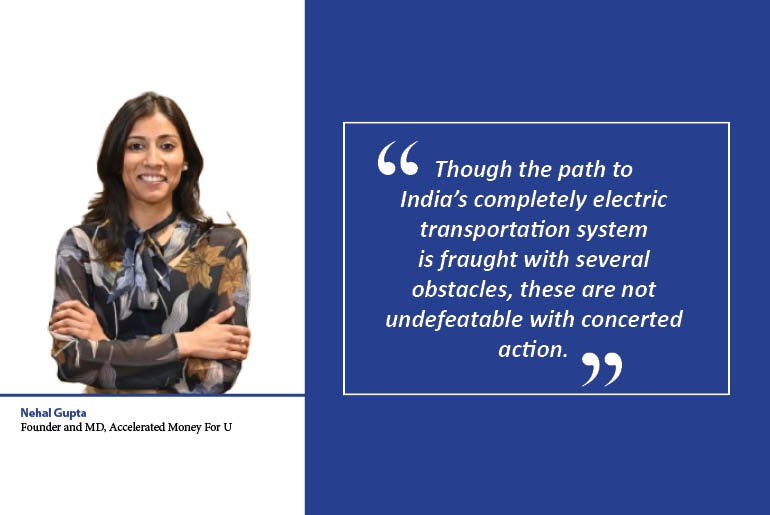India stands at a critical juncture in the electric vehicle (EV) revolution. The government’s key priorities as well as fresh investments from auto giants are undoubtedly encouraging, but one aspect still gets overlooked: electrification of the small fleet and the independent driver. These players, who form the majority of India’s last mile delivery and commercial transport, impatiently look forward to the economic benefits and ecological rewards of EVs.
Still, a significant challenge remains – absence of affordable, timely, and fairly priced credit facilities. This shortcoming in the system of adopting electric vehicles would jeopardize the nation’s vision of green carbon-free transport.
The Hidden Force behind the EV Revolution
Small fleets and solo drivers aren’t just part of the EV revolution, they are its engine. They have a major share of the commercial vehicle industry, where two-wheelers and three-wheelers are the mainstay of last-mile delivery in urban and semi-urban regions. Electrification of this segment has tremendous opportunities for India. According to a report by NITI Aayog, the total capital spending on the nationwide EV transition is estimated to be worth a staggering INR 19.7 lakh crore over the period 2020 to 2030, and by 2030 an annual loan market size of INR 3.7 lakh crore is anticipated. The adoption of electric two- and three-wheelers will account for much of this investment.
The economic case for electricifying these fleets is compelling. With lower operating and maintenance costs, EVs give small businesses and solo entrepreneurs a significant competitive advantage. For a delivery driver, this means greater savings and an improved standard of living. Environmental advantages are equally persuasive. A mass transition to electric two- and three-wheelers would eliminate a large portion of vehicle emissions, leading to cleaner air for our densely populated cities.
The Great Wall of Finance
Despite obvious advantages, purchasing EVs represents a significant financial barrier for small fleet operators and personal motorists. Conventional banks do not want to tap the new EV market since they prefer well-known risk profiles from internal combustion engine (ICE) cars. This reluctance is apparent in several ways:
- Higher Interest Rates: EV loans are usually charged higher interest rates by banks, citing the perceived risk of the new technology and the lack of historic data on vehicle performance and resale.
- Lower Loan-to-Value (LTV) Ratios: In order to minimise their risk, lenders offer lower LTV ratios for EVs, meaning a higher upfront down payment for the borrower. This is a significant hindrance for small companies and those with lesser finances.
- Lack of Customised Financial Products: The conventional lender’s generic strategy cannot address the individual needs of the EV market. There is a lack of innovative financial products that can address the distinctive challenges of EV ownership, such as battery replacement expenses.
The Rise of the Enablers
In view of such challenges, there has emerged a new type of money facilitator. FinTech companies and Non-Banking Financial Companies (NBFCs) are filling in the void left by conventional lenders. Their agile operations and data-driven approaches enable them to create innovative financing models that can meet the needs of the EV ecosystem.
These new-age lenders are leveraging technology to improve the loan application and approval process, making it faster and easier for small businesses and solo drivers. They are also developing sophisticated models for risk assessment that take into account the unique characteristics of EVs, including their lower operational costs and longer lifespan. Some of the innovative solutions being brought in are:
- Digital Lending Platforms: These platforms present a simple and convenient lending experience with online applications, quick approvals, and digital documentation.
- Risk-Sharing Models: NBFCs and FinTech companies are collaborating with EV manufacturers and fleet operators to develop risk-sharing models that share the risk among all stakeholders.
- Battery-as-a-Service (BaaS): This revolutionary idea decouples the battery price from the car, reducing the upfront price of the EV and making it more accessible to the borrower. The user is leased the battery, with a monthly subscription charge.
Though the NBFCs and FinTech companies have a crucial role to play in filling the financing gap, complete EV adoption needs coordination from every important player. Specifically, the government has a critical role to play in developing policies conducive to and facilitating the electrification of small fleets and private drivers.
Though the path to India’s completely electric transportation system is fraught with several obstacles, these are not undefeatable with concerted action. Addressing the issue of availability of credit for small fleets and solo drivers will be paramount to realising the full potential of the EV revolution. It is high time that policymakers, the banking and finance industry, and automakers come together in establishing a collaborative environment that facilitates involvement from all players in this incredible shift in the nation.

